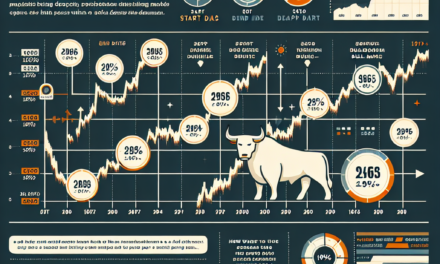“Texas Instruments: Poised for a Comeback After Navigating Sales Slump”
Introduction
Texas Instruments, a leading player in the semiconductor industry, is poised for a resurgence following a recent downturn in sales. The company, renowned for its innovative technology solutions and extensive product portfolio, has faced challenges due to fluctuating market demands and global economic uncertainties. However, with strategic initiatives aimed at enhancing operational efficiency and expanding its market reach, Texas Instruments anticipates a robust recovery. By leveraging its strong research and development capabilities and focusing on emerging growth sectors, the company is well-positioned to capitalize on new opportunities and drive future growth. As the industry landscape evolves, Texas Instruments remains committed to delivering value to its stakeholders and maintaining its competitive edge.
Texas Instruments’ Strategic Plans for Recovery After Sales Decline
Texas Instruments, a prominent player in the semiconductor industry, has recently faced a challenging period marked by a decline in sales. This downturn, attributed to a combination of global economic uncertainties and fluctuating demand in key markets, has prompted the company to reassess its strategies and chart a course for recovery. Despite the current setbacks, Texas Instruments remains optimistic about its future prospects, leveraging its robust technological foundation and strategic initiatives to navigate through these turbulent times.
The decline in sales, while concerning, is not entirely unexpected given the broader economic context. The semiconductor industry, known for its cyclical nature, often experiences periods of volatility influenced by factors such as supply chain disruptions, geopolitical tensions, and shifts in consumer demand. In response to these challenges, Texas Instruments is focusing on strengthening its core competencies and exploring new growth avenues. By investing in research and development, the company aims to enhance its product offerings and maintain its competitive edge in the market.
One of the key strategies Texas Instruments is employing to counteract the sales decline is diversifying its product portfolio. The company is expanding its reach into emerging markets, such as automotive and industrial applications, where the demand for semiconductors is expected to grow significantly. By aligning its product development efforts with these high-growth sectors, Texas Instruments is positioning itself to capture new opportunities and drive revenue growth. Furthermore, the company is committed to maintaining its leadership in analog and embedded processing technologies, which remain critical components of its business model.
In addition to product diversification, Texas Instruments is also focusing on operational efficiency to improve its financial performance. The company is implementing cost-control measures and optimizing its manufacturing processes to enhance productivity and reduce expenses. By streamlining operations, Texas Instruments aims to improve its profit margins and strengthen its financial position, enabling it to weather the current downturn and emerge stronger in the long run.
Moreover, Texas Instruments recognizes the importance of strategic partnerships and collaborations in driving innovation and growth. The company is actively seeking alliances with other industry leaders, research institutions, and technology startups to foster innovation and accelerate the development of cutting-edge solutions. These collaborations not only enhance Texas Instruments’ technological capabilities but also provide access to new markets and customer segments, further supporting its recovery efforts.
As Texas Instruments navigates this challenging period, it remains committed to its long-term vision of delivering value to its customers and shareholders. The company’s leadership is confident that its strategic initiatives, coupled with its strong financial foundation, will enable it to overcome the current obstacles and achieve sustainable growth in the future. By focusing on innovation, operational excellence, and strategic partnerships, Texas Instruments is well-positioned to capitalize on emerging opportunities and drive its recovery.
In conclusion, while the recent sales decline presents a significant challenge for Texas Instruments, the company’s proactive approach and strategic initiatives offer a promising path forward. By leveraging its technological expertise, diversifying its product offerings, and enhancing operational efficiency, Texas Instruments is poised to rebound and continue its legacy of innovation and leadership in the semiconductor industry. As the company adapts to the evolving market landscape, it remains steadfast in its commitment to delivering cutting-edge solutions that meet the needs of its customers and drive long-term success.
Key Factors Influencing Texas Instruments’ Anticipated Rebound
Texas Instruments, a leading player in the semiconductor industry, has recently faced a decline in sales, prompting analysts and stakeholders to closely examine the factors that could influence its anticipated rebound. The company, known for its innovative solutions in analog and embedded processing, has been navigating a challenging landscape marked by fluctuating demand and supply chain disruptions. However, several key factors suggest that Texas Instruments is well-positioned to recover and potentially thrive in the coming quarters.
One of the primary factors contributing to the anticipated rebound is the growing demand for semiconductors across various industries. As the world becomes increasingly digital, sectors such as automotive, industrial, and consumer electronics are experiencing a surge in demand for advanced semiconductor solutions. Texas Instruments, with its extensive portfolio and expertise, is strategically positioned to capitalize on this trend. The company’s focus on analog and embedded processing technologies aligns well with the needs of these industries, providing a solid foundation for future growth.
Moreover, Texas Instruments has been investing significantly in research and development to drive innovation and maintain its competitive edge. By prioritizing R&D, the company aims to develop cutting-edge products that meet the evolving needs of its customers. This commitment to innovation not only enhances its product offerings but also strengthens its market position. As new technologies emerge and industries continue to evolve, Texas Instruments’ ability to deliver innovative solutions will be crucial in capturing new opportunities and driving its rebound.
In addition to technological advancements, Texas Instruments’ robust financial health plays a pivotal role in its anticipated recovery. The company has consistently demonstrated strong financial management, maintaining a healthy balance sheet and generating substantial cash flow. This financial stability provides Texas Instruments with the flexibility to invest in strategic initiatives, expand its manufacturing capabilities, and explore new markets. Furthermore, the company’s disciplined approach to capital allocation ensures that resources are efficiently utilized to maximize shareholder value.
Another factor that could influence Texas Instruments’ rebound is its commitment to sustainability and corporate responsibility. As environmental concerns gain prominence, companies across industries are increasingly prioritizing sustainable practices. Texas Instruments has been proactive in integrating sustainability into its operations, focusing on energy efficiency, waste reduction, and responsible sourcing. By aligning its business practices with global sustainability goals, the company not only enhances its reputation but also attracts environmentally conscious customers and investors. This commitment to sustainability could serve as a differentiating factor, contributing to its long-term success.
Furthermore, Texas Instruments’ global presence and strong customer relationships provide a solid foundation for its recovery. The company has established a vast network of customers and partners worldwide, enabling it to effectively navigate regional market dynamics and capitalize on emerging opportunities. By leveraging its global reach, Texas Instruments can adapt to changing market conditions and tailor its offerings to meet diverse customer needs. This adaptability, coupled with its customer-centric approach, positions the company favorably for a rebound.
In conclusion, while Texas Instruments has faced recent challenges, several key factors indicate a promising path to recovery. The growing demand for semiconductors, coupled with the company’s focus on innovation, financial strength, sustainability, and global presence, positions it well for future growth. As Texas Instruments continues to navigate the evolving landscape, these factors will play a crucial role in driving its anticipated rebound and ensuring its continued success in the semiconductor industry.
Analyzing Texas Instruments’ Market Position Amidst Sales Challenges
Texas Instruments, a stalwart in the semiconductor industry, has recently faced a downturn in sales, prompting analysts and investors to scrutinize its market position. Despite the current challenges, the company remains optimistic about a rebound, driven by strategic initiatives and a robust product portfolio. Understanding the factors contributing to the sales decline and the potential for recovery is crucial for stakeholders looking to navigate the evolving landscape of the semiconductor market.
The recent decline in sales can be attributed to several factors, including global supply chain disruptions and fluctuating demand across key sectors. The semiconductor industry, as a whole, has been grappling with these issues, which have been exacerbated by geopolitical tensions and the lingering effects of the COVID-19 pandemic. Texas Instruments, like many of its peers, has had to contend with these external pressures, which have impacted its ability to meet customer demand consistently.
However, Texas Instruments is not solely reliant on external market conditions. The company has a long-standing reputation for innovation and a diverse product range that spans multiple industries, including automotive, industrial, and consumer electronics. This diversification is a significant asset, as it allows the company to mitigate risks associated with downturns in specific sectors. Moreover, Texas Instruments has been investing heavily in research and development, ensuring that it remains at the forefront of technological advancements. This commitment to innovation is expected to play a pivotal role in the company’s anticipated rebound.
In addition to its focus on innovation, Texas Instruments has been strategically expanding its manufacturing capabilities. The company has announced plans to build new fabrication facilities, which will not only increase production capacity but also enhance its ability to respond to market demands more swiftly. This expansion is particularly timely, given the global push towards digital transformation and the increasing reliance on semiconductors in various applications. By bolstering its manufacturing infrastructure, Texas Instruments aims to position itself as a key player in meeting the growing demand for semiconductors.
Furthermore, Texas Instruments’ financial health provides a solid foundation for weathering the current challenges. The company has maintained a strong balance sheet, with substantial cash reserves and a prudent approach to capital allocation. This financial stability enables Texas Instruments to continue investing in strategic initiatives, even amidst a challenging market environment. It also provides the flexibility to explore potential acquisitions or partnerships that could further strengthen its market position.
Looking ahead, Texas Instruments is optimistic about the opportunities that lie ahead. The increasing adoption of electric vehicles, the proliferation of smart devices, and the expansion of 5G networks are expected to drive demand for semiconductors. Texas Instruments, with its comprehensive product offerings and strategic initiatives, is well-positioned to capitalize on these trends. The company’s focus on sustainability and energy-efficient solutions also aligns with the growing emphasis on environmental responsibility, further enhancing its appeal to customers and investors alike.
In conclusion, while Texas Instruments is currently navigating a period of sales decline, its strategic initiatives and strong market position provide a solid foundation for recovery. By leveraging its innovation capabilities, expanding its manufacturing infrastructure, and maintaining financial stability, the company is poised to rebound and continue its legacy of leadership in the semiconductor industry. As the market evolves, Texas Instruments’ ability to adapt and innovate will be key to its long-term success.
Innovations Driving Texas Instruments’ Future Growth Prospects

Texas Instruments, a stalwart in the semiconductor industry, has recently faced a downturn in sales, a situation not uncommon in the cyclical world of technology. However, the company remains optimistic about its future, driven by a series of innovative strategies and developments that promise to rejuvenate its growth trajectory. As the global demand for semiconductors continues to evolve, Texas Instruments is strategically positioning itself to capitalize on emerging opportunities, ensuring that it remains at the forefront of technological advancements.
One of the key areas where Texas Instruments is focusing its efforts is in the realm of analog and embedded processing. These segments are crucial for a wide array of applications, ranging from automotive to industrial and consumer electronics. By investing in research and development, Texas Instruments aims to enhance the performance and efficiency of its products, thereby meeting the increasing demands of its diverse customer base. This commitment to innovation is expected to not only improve existing product lines but also pave the way for new offerings that can capture untapped market segments.
Moreover, Texas Instruments is leveraging its extensive manufacturing capabilities to gain a competitive edge. The company has made significant investments in expanding its production facilities, ensuring that it can meet the growing demand for semiconductors. This expansion is particularly timely, given the global semiconductor shortage that has affected numerous industries. By increasing its production capacity, Texas Instruments is well-positioned to supply critical components to its clients, thereby strengthening its market position and fostering long-term relationships with key partners.
In addition to manufacturing prowess, Texas Instruments is also focusing on sustainability and energy efficiency, which are becoming increasingly important in the tech industry. The company is actively working on developing products that consume less power and have a smaller environmental footprint. This initiative not only aligns with global sustainability goals but also appeals to environmentally conscious consumers and businesses. By prioritizing eco-friendly innovations, Texas Instruments is not only contributing to a more sustainable future but also enhancing its brand reputation and customer loyalty.
Furthermore, Texas Instruments is exploring opportunities in emerging technologies such as the Internet of Things (IoT) and artificial intelligence (AI). These fields offer vast potential for growth, as they are integral to the development of smart devices and systems. By integrating IoT and AI capabilities into its products, Texas Instruments can offer more sophisticated solutions that cater to the evolving needs of its clients. This strategic focus on cutting-edge technologies is expected to drive significant growth in the coming years, as more industries adopt smart solutions to enhance their operations.
In conclusion, while Texas Instruments has experienced a recent decline in sales, the company’s proactive approach to innovation and strategic investments positions it well for a rebound. By focusing on analog and embedded processing, expanding manufacturing capabilities, prioritizing sustainability, and exploring emerging technologies, Texas Instruments is laying a solid foundation for future growth. As the semiconductor industry continues to evolve, the company’s commitment to innovation and excellence will likely ensure its continued success and leadership in the market. Through these efforts, Texas Instruments anticipates not only recovering from its current challenges but also achieving new heights in its growth journey.
Texas Instruments’ Financial Outlook: Preparing for a Comeback
Texas Instruments, a stalwart in the semiconductor industry, has recently faced a challenging period marked by a decline in sales. However, the company remains optimistic about its future prospects, anticipating a rebound that could restore its financial health and market position. This optimism is not unfounded, as Texas Instruments has a history of resilience and adaptability in the face of market fluctuations. The company’s strategic initiatives and investments in key growth areas are expected to play a pivotal role in its anticipated recovery.
The recent sales decline can be attributed to several factors, including a slowdown in demand across various sectors that utilize Texas Instruments’ products. The global semiconductor industry has been experiencing a cyclical downturn, exacerbated by macroeconomic uncertainties and supply chain disruptions. These challenges have inevitably impacted Texas Instruments’ revenue streams. Nevertheless, the company is leveraging its robust operational framework and diversified product portfolio to navigate these turbulent times.
In response to the current market conditions, Texas Instruments is focusing on strengthening its core business segments, particularly in the areas of analog and embedded processing. These segments have historically been the backbone of the company’s operations, providing a steady stream of revenue and profitability. By enhancing its product offerings and expanding its customer base in these areas, Texas Instruments aims to capitalize on the growing demand for semiconductors in industries such as automotive, industrial, and communications.
Moreover, Texas Instruments is investing in research and development to drive innovation and maintain its competitive edge. The company recognizes that technological advancements are crucial for sustaining long-term growth and meeting the evolving needs of its customers. By prioritizing R&D, Texas Instruments is positioning itself to deliver cutting-edge solutions that can address emerging trends and challenges in the semiconductor landscape.
In addition to its focus on innovation, Texas Instruments is also committed to operational efficiency and cost management. The company has implemented measures to optimize its manufacturing processes and supply chain operations, ensuring that it can respond swiftly to changes in market demand. These efforts are expected to enhance the company’s agility and resilience, enabling it to weather the current downturn and emerge stronger in the future.
Furthermore, Texas Instruments is exploring strategic partnerships and collaborations to expand its market reach and drive growth. By forging alliances with key players in the technology ecosystem, the company can tap into new opportunities and access complementary expertise and resources. These partnerships are likely to play a crucial role in Texas Instruments’ efforts to accelerate its recovery and achieve sustainable growth.
As Texas Instruments navigates this challenging period, its leadership remains confident in the company’s ability to rebound and thrive. The company’s strong financial position, coupled with its strategic initiatives, provides a solid foundation for future success. While the road to recovery may be fraught with challenges, Texas Instruments’ commitment to innovation, operational excellence, and strategic growth positions it well for a comeback.
In conclusion, Texas Instruments is poised for a rebound following its recent sales decline. By focusing on its core strengths, investing in innovation, and pursuing strategic partnerships, the company is preparing to overcome current challenges and capitalize on future opportunities. As the semiconductor industry continues to evolve, Texas Instruments’ proactive approach and unwavering commitment to excellence are likely to drive its resurgence and reaffirm its status as a leader in the field.
The Role of Global Market Trends in Texas Instruments’ Recovery
Texas Instruments, a prominent player in the semiconductor industry, has recently faced a decline in sales, a situation that has prompted the company to anticipate a rebound by closely examining global market trends. The semiconductor sector, known for its cyclical nature, often experiences fluctuations influenced by various external factors. In this context, understanding the role of global market trends becomes crucial for Texas Instruments as it strategizes for recovery.
To begin with, the global demand for semiconductors is intricately linked to the broader technological landscape. As industries such as automotive, consumer electronics, and telecommunications continue to evolve, the demand for advanced semiconductor solutions is expected to rise. Texas Instruments, with its diverse portfolio of analog and embedded processing products, is well-positioned to capitalize on these emerging opportunities. The increasing adoption of electric vehicles, for instance, necessitates sophisticated semiconductor components, a trend that Texas Instruments can leverage to drive growth.
Moreover, the ongoing digital transformation across various sectors further underscores the potential for recovery. As businesses and consumers increasingly rely on digital solutions, the demand for semiconductors that enable connectivity, data processing, and power management is set to grow. Texas Instruments, by aligning its product offerings with these technological advancements, can tap into new revenue streams. The company’s focus on innovation and research and development will be instrumental in creating cutting-edge solutions that meet the evolving needs of the market.
In addition to technological advancements, geopolitical factors also play a significant role in shaping the semiconductor industry. Trade tensions and regulatory changes can impact supply chains and market access, influencing the sales performance of companies like Texas Instruments. However, by diversifying its manufacturing and supply chain operations, the company can mitigate potential risks and ensure a steady supply of products to meet global demand. This strategic approach not only enhances resilience but also positions Texas Instruments to swiftly respond to changes in the geopolitical landscape.
Furthermore, the global push towards sustainability presents another avenue for growth. As industries strive to reduce their carbon footprint, the demand for energy-efficient semiconductor solutions is on the rise. Texas Instruments, with its commitment to sustainability, can develop products that align with these environmental goals. By prioritizing energy-efficient technologies, the company can attract environmentally conscious customers and strengthen its market position.
While these global market trends offer promising prospects, Texas Instruments must also navigate challenges such as supply chain disruptions and competitive pressures. The semiconductor industry is characterized by rapid technological advancements and intense competition, necessitating continuous innovation and strategic partnerships. By fostering collaborations with key industry players and investing in cutting-edge technologies, Texas Instruments can enhance its competitive edge and drive its recovery efforts.
In conclusion, Texas Instruments’ anticipation of a rebound following a sales decline is intricately linked to its ability to harness global market trends. By aligning its strategies with technological advancements, geopolitical dynamics, and sustainability goals, the company can position itself for growth in the evolving semiconductor landscape. As Texas Instruments navigates these complex factors, its focus on innovation, resilience, and strategic partnerships will be pivotal in achieving a successful recovery and sustaining its leadership in the industry.
Texas Instruments’ Investment in R&D as a Catalyst for Rebound
Texas Instruments, a stalwart in the semiconductor industry, has recently faced a downturn in sales, prompting the company to strategize for a rebound. Despite the current challenges, Texas Instruments remains optimistic about its future, largely due to its substantial investment in research and development (R&D). This commitment to innovation is expected to serve as a catalyst for recovery, positioning the company to capitalize on emerging opportunities in the technology sector.
The decline in sales can be attributed to several factors, including global supply chain disruptions and fluctuating demand in key markets. However, Texas Instruments has a history of resilience, having navigated similar challenges in the past. The company’s strategic focus on R&D is not only a response to the current downturn but also a proactive measure to ensure long-term growth and competitiveness. By prioritizing innovation, Texas Instruments aims to develop cutting-edge technologies that will meet the evolving needs of its customers.
Investing in R&D is a cornerstone of Texas Instruments’ business strategy. The company allocates a significant portion of its revenue to research initiatives, which has historically resulted in a robust pipeline of new products and technologies. This commitment to innovation is evident in the company’s diverse portfolio, which spans various sectors, including automotive, industrial, and consumer electronics. By continuously enhancing its product offerings, Texas Instruments seeks to maintain its leadership position in the semiconductor industry.
Moreover, the company’s focus on R&D is aligned with broader industry trends, such as the increasing demand for semiconductors in emerging technologies like electric vehicles, renewable energy, and the Internet of Things (IoT). These sectors present significant growth opportunities, and Texas Instruments is well-positioned to leverage its expertise to capture a share of these expanding markets. By developing innovative solutions tailored to these applications, the company aims to drive future revenue growth and offset the recent decline in sales.
In addition to product innovation, Texas Instruments is also investing in process improvements and manufacturing capabilities. The company recognizes that efficient production processes are crucial for maintaining cost competitiveness and ensuring timely delivery of products to customers. By enhancing its manufacturing operations, Texas Instruments aims to improve its supply chain resilience and better respond to market fluctuations. This holistic approach to R&D underscores the company’s commitment to excellence and its determination to emerge stronger from the current challenges.
Furthermore, Texas Instruments’ investment in R&D is complemented by strategic partnerships and collaborations with academic institutions and industry leaders. These alliances facilitate knowledge exchange and foster innovation, enabling the company to stay at the forefront of technological advancements. By leveraging external expertise and resources, Texas Instruments can accelerate the development of new technologies and bring them to market more quickly.
In conclusion, while Texas Instruments is currently experiencing a decline in sales, its robust investment in R&D is expected to serve as a catalyst for recovery. By prioritizing innovation and aligning its efforts with industry trends, the company is well-positioned to capitalize on emerging opportunities and drive future growth. As Texas Instruments continues to enhance its product offerings and manufacturing capabilities, it remains committed to maintaining its leadership position in the semiconductor industry. Through strategic investments and collaborations, the company is poised to rebound from the current challenges and achieve long-term success.
Q&A
1. **What caused the sales decline for Texas Instruments?**
The sales decline was primarily due to reduced demand in key markets such as automotive and industrial sectors, along with global supply chain disruptions.
2. **How much did Texas Instruments’ sales decline?**
Sales declined by approximately 10% compared to the previous quarter, reflecting the challenges faced in the market.
3. **What is Texas Instruments’ strategy for a rebound?**
Texas Instruments plans to focus on expanding its product portfolio, investing in new technologies, and enhancing its manufacturing capabilities to meet anticipated demand.
4. **Which markets are expected to drive the rebound for Texas Instruments?**
The automotive and industrial markets are expected to be significant drivers of the rebound, as demand in these sectors is projected to recover.
5. **What role does innovation play in Texas Instruments’ rebound strategy?**
Innovation is crucial, with the company investing in research and development to create advanced semiconductor solutions that cater to emerging market needs.
6. **How is Texas Instruments addressing supply chain issues?**
The company is working on diversifying its supplier base and increasing its inventory levels to mitigate future supply chain disruptions.
7. **What are analysts’ expectations for Texas Instruments’ future performance?**
Analysts are cautiously optimistic, expecting a gradual recovery in sales as market conditions improve and the company’s strategic initiatives take effect.
Conclusion
Texas Instruments is poised for a recovery after experiencing a decline in sales. The company is likely focusing on strategic initiatives to address the challenges that led to the downturn, such as enhancing product offerings, optimizing supply chain operations, and targeting growth markets. By leveraging its strengths in innovation and adapting to market demands, Texas Instruments aims to regain momentum and improve its financial performance. The anticipated rebound reflects confidence in the company’s ability to navigate the current economic landscape and capitalize on emerging opportunities in the semiconductor industry.





